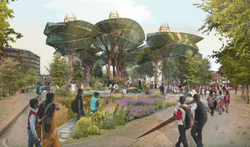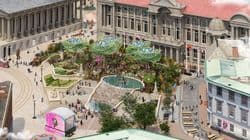Meet Jane Memmott: ecologist and entomologist
Jane Memmott OBE is an ecologist and entomologist, and professor of ecology at the University of Bristol. Jane is an expert on the interactions between insect pollinators and plants, and in particular the role that cities can play as a home to pollinators.
You may have read on our website the surprising fact that inspired PoliNations: that 80% of plants in UK city-gardens originated overseas. This fact came from research by Jane.
We spoke to Jane about her background, research, and some of her top tips for promoting pollinator abundance in the green spaces we occupy...
Could you tell us a bit about yourself and your research, and how you came to be involved with the PoliNations research and development process?
I’ve been interested in natural history, particularly insects, for as long as I can remember. I can clearly remember finding a huge furry, caterpillar in the hedge at infants school and it turned into a huge red and black stripy tiger moth. It seemed like magic at the time, and it still does to be honest, even though I now understand exactly how it happens. I began research on pollinators about 20 years ago and have been working on them ever since. They are endlessly fascinating, and I’ve run lots of projects on their ecology and conservation here in the UK and am currently working on a large pollination project in Nepal, looking at how climate change, pollination, crop harvests and human health interact.
I got involved with PoliNations project right at the start. I was contacted by the Brigstow Institute at Bristol University about an event that Trigger Stuff was wanting to run. It was described to me as a “mass participatory growing artwork” and it sounded intriguing. I’ve always been interested in the links between art and science and think that both sides get a lot out of working together.
PoliNations emerged from a surprising fact you discovered through your research: that over 80% of plants in UK gardens come from overseas. Can you tell us about how you came to land at this figure, and expand a bit on what it means?
This figure came out towards the end of a 10-year stint working on pollinators in towns and cities. This research programme started as a large interdisciplinary project with academics working with conservation practitioners in UK cities and asked how many pollinators are found in four UK cities – Bristol, Reading Leeds and Edinburgh - compared with farmland and nature reserves. We were very interested in using the data we collected to work out how to make cities better habitats for pollinators.
When this project ended, a PhD student called Nick Tew continued the research in urban habitats. He used the data on the number of flowers in the four cities and added information on the amount of nectar in each flower species. He found that the vast majority of the plants in gardens came from overseas and that these contributed most of the nectar in the gardens. We were looking at lots of different things in this project, but the fact that most of the plants in British gardens come from overseas, was the one that caught the imagination of the Trigger Stuff team.
We’re interested in your research on Urban Pollinators. Could you tell us a bit about the importance of cities as a home for pollinators?
Cities can be very good places for pollinators to live; indeed, there are more species of bee in cities than in the surrounding farmland. That said, it tends to be the common species that you find in cities – you don’t find the pollinator species that need habitats like sand dunes, salt marshes or ancient woodland in cities. Rather those species need nature reserves or farms with patches of natural habitat on them. But cities can be fantastic places for many pollinator species and given that most people in the UK live in urban areas it’s where most people get to see pollinators too.
Many councils are planting pollinator friendly flower beds – to the joy of the local people as well as the pollinators.
Do you have advice for what we can do on an individual and community level to promote pollinator abundance in the green spaces we occupy?
There is lots we can do to encourage pollinators. As an individual if you have a garden or allotment just make sure there are plenty of flowers in there of all sorts of shapes and sizes. Our research showed that garden size really doesn’t matter – it’s what you grow there that counts! So, grow as many species of flowering plants as you can, for as long as you can, so that both you and the pollinators get to enjoy the flowers from the first signs of spring until October/November.
Many gardens have a lawn and these look much nicer with some flowers in them, so encourage flowers like daisies and clover to grow there - go for the Persian carpet look, rather than a boring billiard table! Plant flowers and pollinators will come – it’s 100% guaranteed. And once you have some plants in place, perhaps try installing some bee homes – most garden centres sell nesting sites for solitary bees and there are many recipes for making these for free online too.
At the community level, you can join a Friends group for a local greenspace and get involved with making it pollinator friendly – this nearly always involves more flowers which makes people happy too. Or join a local wildlife group, everyone will have a local Wildlife Trust and nearly all of them will be interested in pollinators.
Is there anything we can do if we don’t have a garden?
If you don’t have a garden, then there is still loads you can do. One of my first homes was a first floor flat. It didn’t have a garden, but it had steps up to the front door and I had 3 large plant pots on the doorstep with lots of pollinator friendly plants. Those three pots were my first garden and I remember them very fondly. These days I have a garden but on my walk into work in Bristol, I walk past a house in the mornings whose front door opens directly onto the street, but the owner has taken over both sides of the pavement and I walk 20 paces through a corridor of flowers, which makes me smile every day and it’ll make the local pollinators happy too.
If you have a flat with a balcony, then there is even more you can do. Grow potted plants like lavender which pollinators adore, and which likes growing in dry windy places. Grow herbs too – herbs like mint, thyme, marjoram and sage all have very attractive flowers for pollinators, and you can put their leaves on your pizza too! Leave space for a couple of chairs and a cup of tea/glass of wine so you can enjoy watching pollinators visiting your flowers.
And if feeling really ambitious, try adding a solitary bees nest to your garden, balcony or allotment. Here’s mine at the peak of the solitary bee season. They won’t sting unless you hold them tightly and it’s very relaxing watching them coming and going carrying their cargo of pollen and leaves.
In my garden right now in early September, my pineapple lilies (from South Africa) and Dahlias (from Mexico) are very popular with pollinating insects. (images below)






